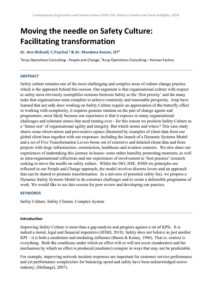| Document | Author Dr. Ann Bicknell, C.Psychol. & Dr. Mandana Kazem, IET |
| Abstract Safety culture remains one of the most challenging and complex areas of culture change practice which is the approach behind this session. Our argument is that organisational culture with respect to safety most obviously exemplifies tensions between Safety as the ‘first priority’ and the many tasks that organisations must complete to achieve continuity and reasonable prosperity. Arup have learned that not only does working on Safety Culture require an appreciation of the butterfly effect in working with complexity, it requires genuine stamina on the part of change agents and programmes, most likely because our experience is that it exposes so many organisational challenges and reluctant stones that need turning over - for this reason we position Safety Culture as a ‘litmus test’ of organisational agility and integrity. But which stones and where? This case study shares some observations and provocative opines illustrated by examples of client data from our global client base together with our responses: including the launch of a Dynamic Systems Model and a set of Five Transformation Levers borne out of extensive and detailed client data and from projects with large infrastructure, construction, healthcare and aviation contexts. We also share our experiences of undertaking this journey in-house: some rather humility promoting moments, as well as intra-organisational reflections and our experiences of involvement in ‘best practice’ research seeking to move the needle on safety culture. Whilst the ISO, HSE, IOSH etc principles are reflected in our People and Change approach, the model involves discrete levers and an approach that can be shared to promote transformation. In a universe of potential safety foci, we propose a Dynamic Safety Systems Model to de-construct challenges and to create a defensible programme of work. We would like to use this session for peer review and developing our practice. |

